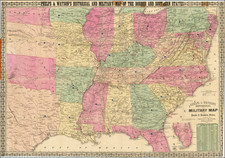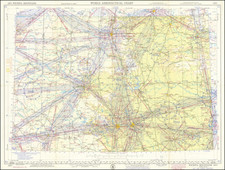Map of Seminole Nation, lithographed by Julius Bien & Co. and included in the Ninth Annual Report Commission to the Five Civilized Tribes, provides a clear representation of the territories of the Seminole Nation. The lands that were allotted are marked in red, while the reservations and district schools are highlighted in blue. This map specifically covers the region between the North Fork Canadian River and the Canadian River.
The Seminole Nation's history, as one of the "Five Civilized Tribes," has been one of complex interactions with the United States government throughout the 19th and early 20th centuries. The term "civilized" in this context refers to the tribes' adaptation of some European-American customs and their generally peaceful coexistence with white settlers. However, these tribes, including the Seminole, faced a series of challenges, including forced relocations and territorial divisions. This map provides a visual record of such divisions and the territorial boundaries established during that period.
The color distinctions on the map, differentiating allotted lands from reservations and educational institutions, illustrate the organized attempts to structure and define Seminole territory within the broader context of American expansion. The map also serves as a testament to the Seminole's attempts to maintain their identity and way of life amidst these changes, as evidenced by the marked district schools focused on education and cultural continuity.
Julius Bien (1826-1909) was a German-born American lithographer and cartographer, renowned for his significant contributions to American cartography during the 19th century. Born on September 27, 1826, in Naumburg, Germany, Bien originally trained in his homeland, mastering the nascent craft of chromolithography, a method for producing multi-color prints.
In the 1850s, Bien emigrated to the United States, where he set up his own lithography firm, Julius Bien & Co., in New York. His innovative techniques and meticulous attention to detail quickly earned him a reputation as one of the country's leading lithographers. The firm became known for its wide range of work, from maps and atlases to commercial prints and illustrations.
One of Bien's most significant collaborations was with the U.S. government, particularly the U.S. Geological Survey (USGS). In the late 19th century, the USGS undertook the ambitious project of mapping the entire United States. Bien's firm was responsible for producing many of these topographical maps, and he introduced advanced printing techniques that enhanced their clarity, precision, and detail.
However, not all of Bien's ventures were successful. His attempt at reproducing a double elephant folio edition of Audubon's Birds of America in the 1860s, for instance, was left incomplete due to financial challenges posed by the Civil War. Despite this, many of the plates he did produce for this edition are considered masterpieces of chromolithography.
Julius Bien passed away on December 21, 1909, in New York. His contributions to lithography and cartography in the U.S. left a lasting legacy, with many of his techniques becoming standard practice in the field. His maps, in particular, serve as a testament to the evolving understanding and depiction of the American landscape during a period of rapid westward expansion and scientific exploration.










![[Kansas City - Witchita - Tulsa - Enid - Springfield] Kansas River (360) World Aeronautical Chart](https://storage.googleapis.com/raremaps/img/small/96224.jpg)


![[ Indian Territory / North Texas / Arkansas ] General Topographical Map. Sheet XXIV. Plate CLIX](https://storage.googleapis.com/raremaps/img/small/95113.jpg)
![[Original photograph:] Native American group image, possibly in Indian Territory, with White Settlers](https://storage.googleapis.com/raremaps/img/small/82871.jpg)